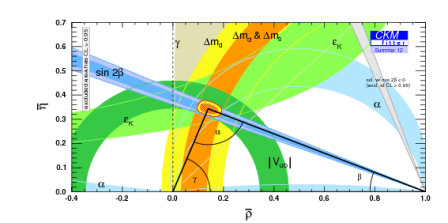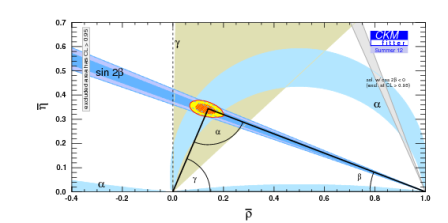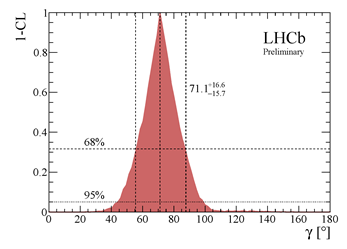[ γ = (71.1+16.6-15.7)° only B±→DK decays ]
[ γ = 85.1° uncertainty regions [61.8,67.8]° and [77.9,92.4]°, B±→DK and B±→Dπ decays ]
LHCb is an experiment set up to explore what happened after the Big Bang that allowed matter to survive and build the Universe we inhabit today. Therefore LHCb physicists are measuring differences between properties of matter and antimatter, called CP violation by experts. CP violation was discovered experimentally in K meson decays in 1964. M. Kobayashi and T. Maskawa proposed in 1973 a mechanism which could incorporate CP violation within the Standard Model with not less than 6 quarks; they were awarded the Nobel prize of Physics in 2008 for this idea. The size of this violation is set by the parameter η, which is shown as the y axis in the figures below. Constraints on η and the related parameter ρ (the x-axis) are measured in various ways in different experiments as shown in the compilation made by the CKMfitter group in the left image below. The constraints show that in fact the values of ρ and η within the small colored region in the center of the images are compatible with the experimental results and confirm in this way the Kobayashi and Maskawa Standard Model mechanism of CP violation. However, since this mechanism does not explain the large quantity of matter observed in the Universe physicists are searching for other sources of CP violation outside the Standard Model.
An interesting possibility is to measure precisely the angle γ of the triangle shown in the right image below in processes in which the new physics contribution is possible and in processes in which it is not. Differences between measurements in these two cases would be a sign of new physics. The measurement of the angle γ in different processes is one of most important goals of the LHCb experiment. The value of this angle is known up to now with precision of only about 10 or 12°, as seen in the right image below, using the combination of results from other experiments.
click the image for higher resolution
LHCb physicists have just presented at the 7th International Workshop on the CKM Unitarity Triangle, Cincinnati, Ohio, USA, the measurement of the angle γ in processes where the contribution of new physics is not expected. These measurements will set a base for comparison with the measurement where observation of new physics effects is possible. The B±→DK and B±→Dπ decays were used with D mesons decays into KK, ππ, K0Sππ, K0SKK or Kπππ. The value of the angle γ = (71.1+16.6-15.7)° was obtained using only B±→DK decay results in the analysis. The image at the left hand side shows the confidence level of the signal as a function of angle γ, for the combination of B±→DK modes. The peak of the distribution gives the measured central value, and the width gives the error. The best value of the angle γ = 85.1° was obtained with the two corresponding uncertainty regions [61.8,67.8]° and [77.9,92.4]° (at 68% CL) when the B±→Dπ decays were included in addition.
The 2011 data sample (1.0 fb-1) was used in this analysis. The precision of the γ angle measurement is already comparable with that achieved by other experiments and the value of this angle is now known to a precision of less than 10 degrees, when this result is averaged with the latest results of other experiments. LHCb physicists are working on analyses of other decay modes that can help improve the precision. It is interesting to note that the data collected by LHCb in 2012 already exceeds the sample from 2011 and by the end of the year the total dataset should have more than tripled.
More details can be found in the LHCb presentation in Cincinnati and in the LHCb Conference Contribution here. Read also the CERN Courier article and the CERN Bulletin article in English and French.



